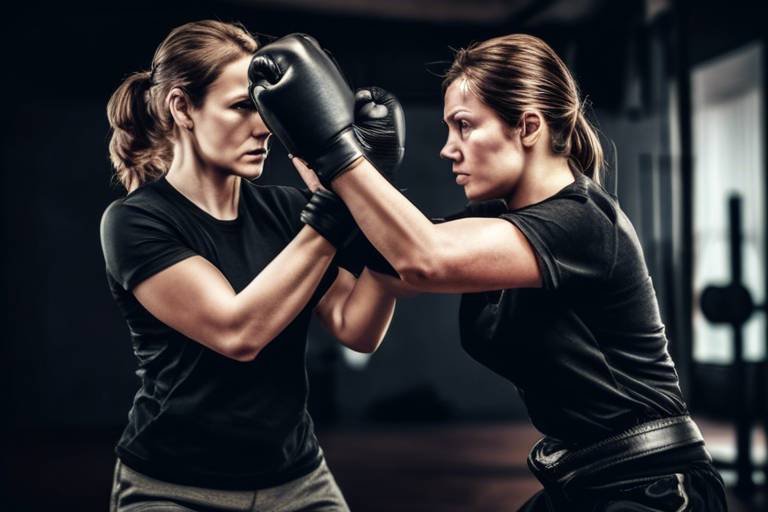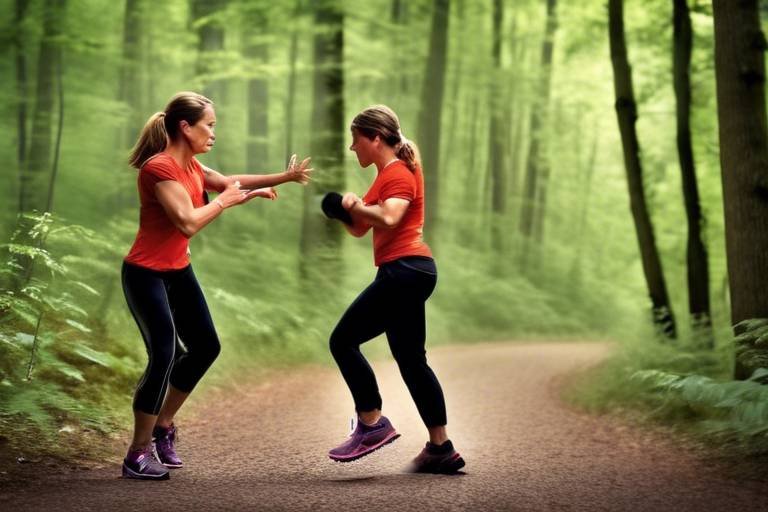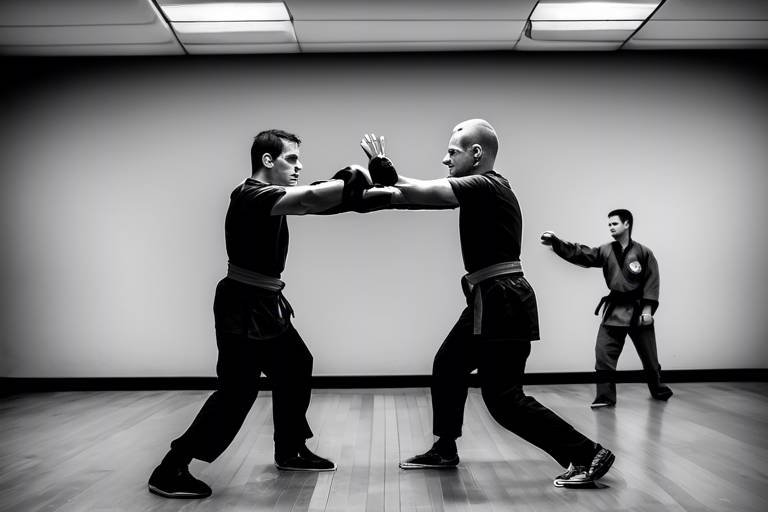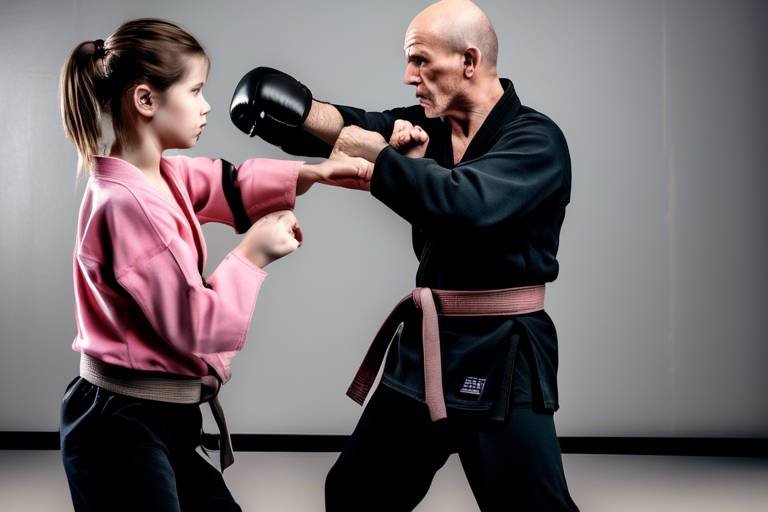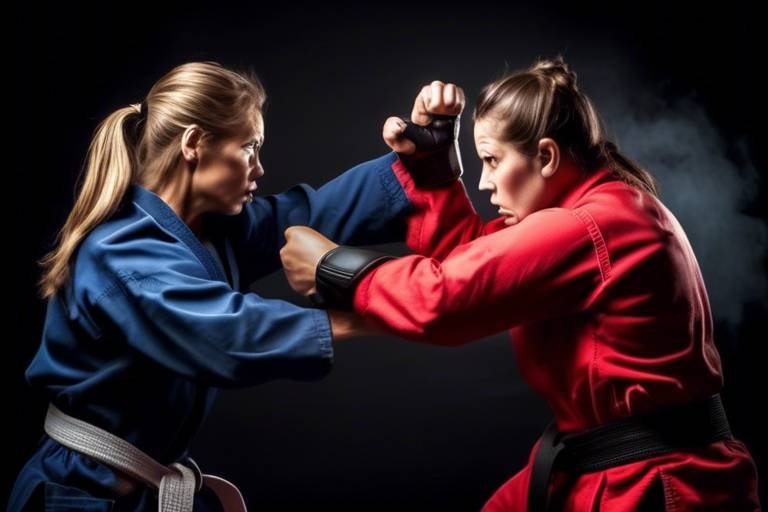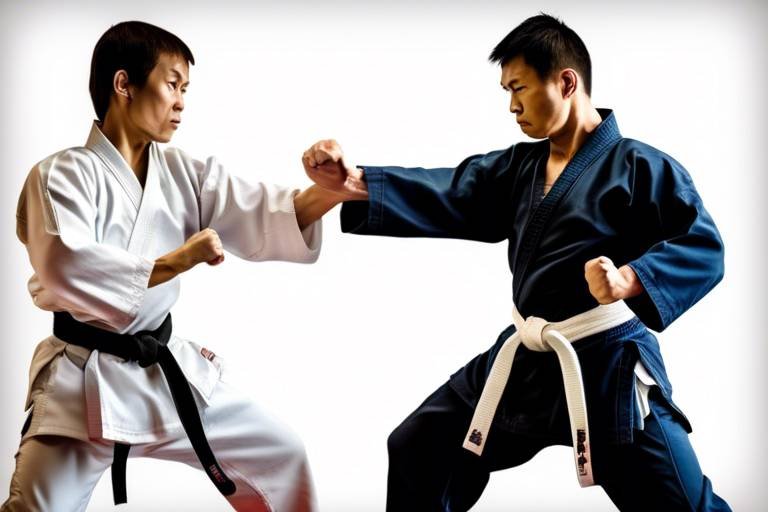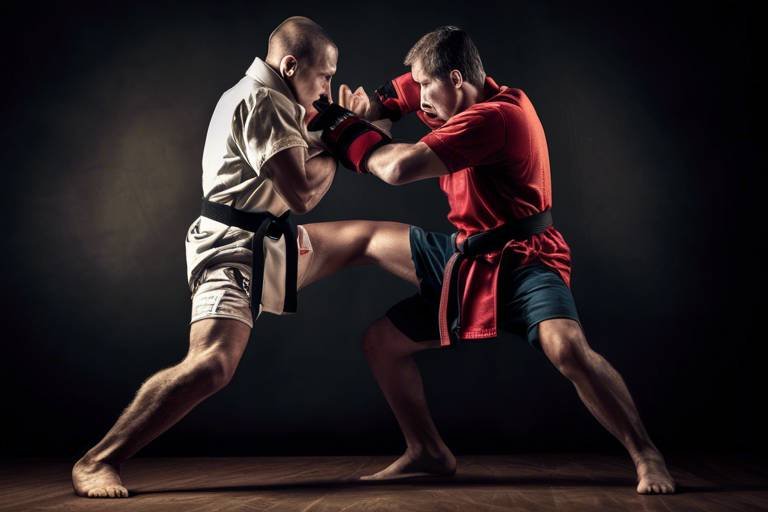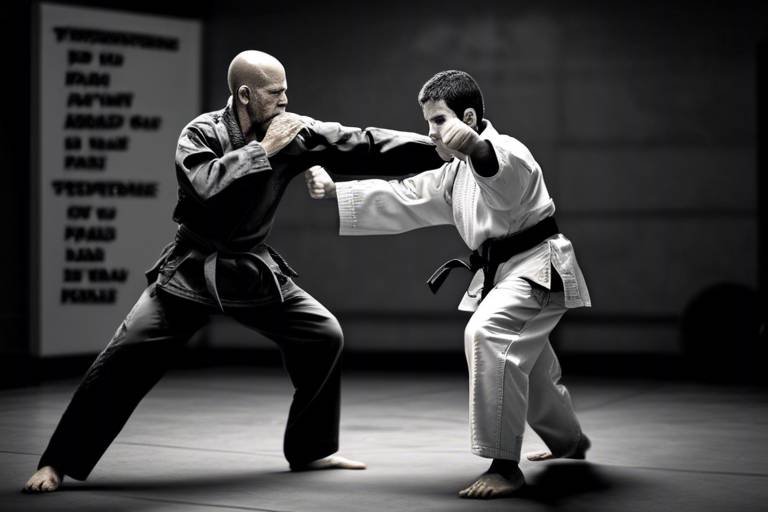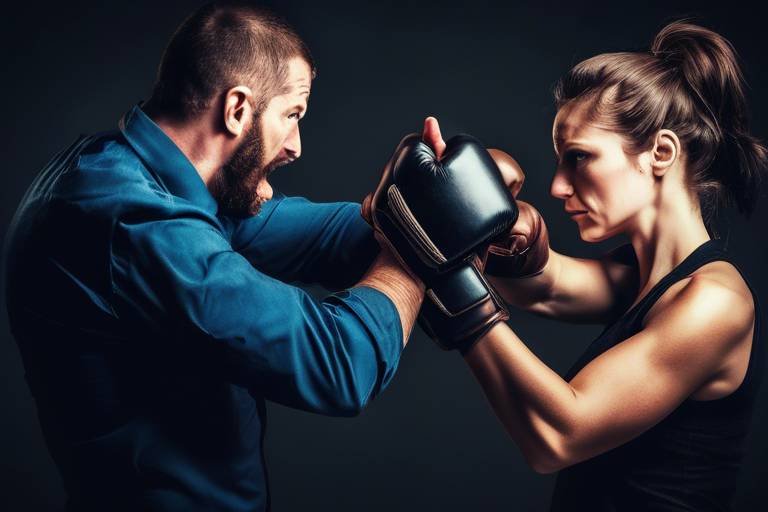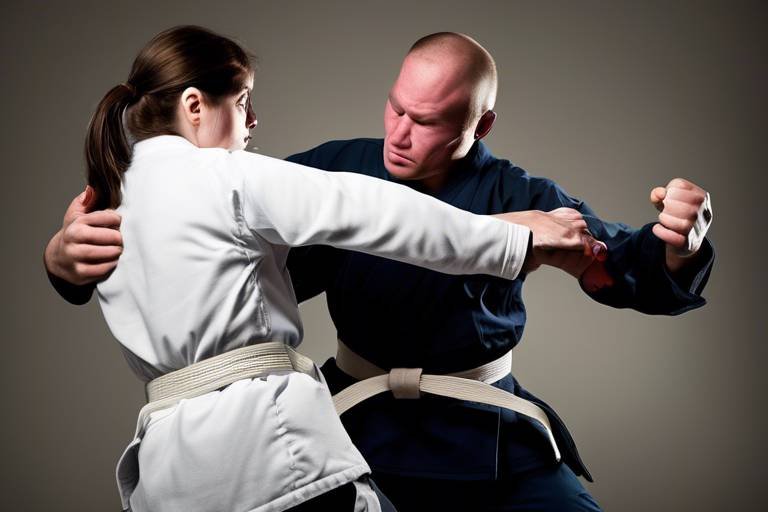Self-Defense Techniques for Lone Travelers
Traveling solo can be one of the most exhilarating experiences of your life. However, it can also present unique challenges, especially when it comes to personal safety. As a lone traveler, it's essential to equip yourself with effective self-defense techniques that not only protect you but also empower you to navigate unfamiliar environments with confidence. In this article, we'll explore practical self-defense strategies, tools, and mindset tips that every solo adventurer should know. Whether you're wandering through bustling city streets or trekking through remote landscapes, understanding how to defend yourself can make all the difference.
Self-defense isn't just about physical techniques; it's also about adopting a proactive mindset and being aware of your surroundings. Imagine walking through a crowded market, the vibrant colors and sounds enveloping you, yet your senses are heightened. You notice the subtle shifts in the crowd, the way someone lingers a bit too long, or how a group of individuals seems to be watching you. This awareness can be your first line of defense. It's not about living in fear, but rather about embracing a sense of vigilance that keeps you one step ahead.
In the following sections, we'll delve deeper into the importance of situational awareness, how to recognize potential threats, and the self-defense techniques that can be employed if the need arises. We'll also discuss personal safety tools that can serve as your allies during your travels. By the end of this article, you'll be equipped with the knowledge and confidence to tackle your adventures head-on, ensuring that your journey is as safe as it is memorable.
Self-defense is crucial for lone travelers, as it empowers individuals to protect themselves in unfamiliar environments. Knowing how to react can significantly increase personal safety and confidence on the road. Imagine you're in a foreign city, and suddenly you find yourself in a sketchy situation. Having the skills to defend yourself not only helps you physically but also boosts your mental resilience. It’s about taking control of your circumstances and ensuring that you can navigate through any challenges that may arise.
Being aware of your surroundings is a key self-defense strategy. Enhancing your situational awareness allows you to identify potential threats and avoid dangerous situations before they escalate. Think of it as having a sixth sense; you’re attuned to the subtle cues in your environment that could indicate danger. This awareness can help you steer clear of risky areas or suspicious individuals, allowing you to enjoy your travels without unnecessary worry.
Learning to recognize signs of danger can help travelers avoid confrontations. Common behaviors and situations that may indicate a threat include:
- Someone following you for an extended period.
- Groups of individuals loitering in a way that feels uncomfortable.
- People displaying aggressive body language or making direct eye contact.
By being vigilant and recognizing these signs early, you can take timely action, such as changing your route or seeking help, which could prevent a confrontation altogether.
Understanding your environment is essential for lone travelers. Knowing which areas are safe and which are not can significantly enhance your safety. Familiarize yourself with the neighborhoods you’re visiting, and use maps to identify potential risks. Always keep your phone charged and have emergency contacts readily available. This preparation can be your safety net, ensuring that you’re never caught off guard.
Interpreting body language can offer insights into people's intentions. Learning how to read non-verbal signals can help you gauge potential threats in different scenarios. For instance, if someone approaches you with a closed posture—arms crossed, avoiding eye contact—this may indicate discomfort or aggression. Conversely, open body language, such as relaxed arms and a friendly demeanor, usually signals a more positive interaction. Being able to differentiate between these cues can be a valuable skill in keeping yourself safe.
This section outlines practical self-defense techniques that travelers can use if confronted. These techniques are designed to be effective yet easy to learn and apply in real-life situations. For example, consider the following techniques:
- Targeting Vulnerable Areas: If you find yourself in a threatening situation, aim for vulnerable areas such as the eyes, nose, throat, or groin. A quick jab or strike can create the opportunity you need to escape.
- Using Your Voice: Shouting for help can draw attention and deter an attacker. Use a strong, assertive voice to command attention.
Remember, the goal of self-defense is not to engage but to escape and seek safety.
Personal safety tools can enhance a traveler’s ability to defend themselves. Tools such as pepper spray, personal alarms, and self-defense keychains can serve as effective deterrents. Carrying these items provides an added layer of security, allowing you to feel more at ease during your travels.
Selecting the appropriate personal safety tools depends on individual needs and travel conditions. Consider factors such as local laws, your comfort level with using certain tools, and the environments you’ll be in. For instance, pepper spray may be effective in urban settings, whereas a personal alarm could be more suitable for rural areas. The key is to choose tools that you’re comfortable using and that align with your travel plans.
Understanding the legal implications of using self-defense tools is vital for travelers. Laws regarding self-defense weapons can vary significantly from one country to another. Research the regulations in the locations you plan to visit to ensure compliance and safe usage. Ignorance of the law can lead to unnecessary complications, so being informed is crucial for your safety.
1. What should I do if I feel threatened while traveling?
Stay calm, assess the situation, and look for an exit. If necessary, use your voice to draw attention or employ self-defense techniques if confronted.
2. Are self-defense tools legal everywhere?
No, self-defense laws vary by location. Always research local laws regarding the possession and use of self-defense tools before traveling.
3. How can I improve my situational awareness?
Practice being mindful of your surroundings, observe people’s behaviors, and avoid distractions such as your phone while walking in unfamiliar areas.

Understanding the Importance of Self-Defense
When you’re out there exploring the world on your own, the last thing you want is to feel vulnerable. That’s where self-defense comes into play. It's not just about learning to throw a punch or kick; it's about empowering yourself with the knowledge and skills to protect your personal safety in unfamiliar environments. Think of self-defense as your travel insurance—just like you wouldn’t venture out without coverage, you shouldn’t travel without knowing how to defend yourself.
Self-defense is crucial for lone travelers for a multitude of reasons. First and foremost, it significantly boosts your confidence. When you know you have the ability to protect yourself, you can immerse yourself in the experience without constantly worrying about your safety. Imagine walking through a bustling market in a foreign country, feeling the vibrant energy around you. If you’re confident in your self-defense skills, you can enjoy the moment instead of scanning the crowd for potential threats.
Moreover, understanding self-defense techniques can help you react swiftly and effectively in dangerous situations. It’s all about being prepared. When faced with a threat, hesitation can be your worst enemy. Knowing how to respond can mean the difference between escaping a bad situation and becoming a victim. This is why it’s essential to equip yourself with practical strategies that you can easily recall in moments of panic.
But self-defense isn’t just physical; it’s also a mindset. Adopting a self-defense mentality involves being aware of your surroundings and recognizing potential dangers before they escalate. This proactive approach can help you avoid confrontations altogether. Here are some key aspects to consider:
- Awareness: Stay alert to your surroundings and the people in them.
- Preparation: Have a plan of action in case of an emergency.
- Confidence: Carry yourself with assurance; it can deter potential threats.
In summary, self-defense is not just a series of physical techniques; it’s a comprehensive approach that encompasses awareness, preparedness, and the right mindset. By investing time in learning self-defense, you’re not just protecting yourself; you’re enhancing your travel experience, allowing you to explore the world with a sense of security and freedom. So, whether you’re wandering through a quiet village or navigating a crowded city, knowing how to defend yourself can make all the difference.

Situational Awareness
When it comes to traveling alone, one of the most powerful tools you can possess is a heightened sense of . This means being acutely aware of your surroundings and the people in them. Think of it as having your own personal radar system that helps you detect potential threats before they become real problems. Imagine walking through a busy market; instead of getting lost in the vibrant colors and sounds, you’re scanning the crowd, noting who seems out of place or who’s acting suspiciously. This proactive approach can significantly enhance your safety.
So, how do you cultivate this keen sense of awareness? First and foremost, it requires practice and a conscious effort to stay present. When you’re engrossed in your phone or daydreaming, you become an easy target. Instead, try to engage your senses actively. Listen to the sounds around you, observe the movements of people, and take note of your environment. Familiarize yourself with the layout of places you visit, as this can help you identify exits and safe spots in case of an emergency.
Part of being aware is learning to recognize potential threats. Not every stranger is a danger, but certain behaviors can signal trouble. For instance, if someone is following you too closely or making you feel uncomfortable, trust your instincts. Common signs of potential threats can include:
- People loitering in an area without a clear purpose.
- Individuals who seem overly interested in your belongings.
- Sudden changes in a person's behavior, such as becoming agitated or aggressive.
By being vigilant and recognizing these signs early, you can take action before situations escalate. It’s like being the main character in a thriller movie—you need to be aware of the plot twists before they happen!
Your environment plays a significant role in your safety. Understanding which areas are safe and which are not can mean the difference between a pleasant stroll and a dangerous encounter. Before you travel, take some time to research your destination. Look for information on safe neighborhoods, local customs, and areas to avoid. Utilize resources like travel blogs, forums, and even local news outlets to get a feel for the environment. When you arrive, trust your gut—if a place feels off, it probably is. Don’t hesitate to change your route or seek help if needed.
Another vital aspect of situational awareness is being able to interpret body language cues. People communicate a lot through their posture, gestures, and facial expressions, often more than they do with words. For example, someone who is tense, with clenched fists or a furrowed brow, might indicate hostility or aggression. Conversely, open and relaxed body language typically signals friendliness. By learning to read these non-verbal signals, you can gauge the intentions of those around you. It’s like having an internal compass that guides you through social interactions, helping you avoid potential conflicts.
In conclusion, situational awareness is an essential skill for any lone traveler. By actively engaging with your environment, recognizing potential threats, and interpreting body language, you can significantly enhance your safety and confidence while exploring new places. Remember, the world is full of opportunities, but being aware can help you seize them without compromising your safety.
Q: How can I improve my situational awareness while traveling?
A: To enhance your situational awareness, practice mindfulness, stay off your phone, and engage your senses. Regularly scan your surroundings and trust your instincts.
Q: What should I do if I feel threatened?
A: If you feel threatened, try to remove yourself from the situation as quickly as possible. Seek help from authorities or nearby individuals if necessary.
Q: Are there specific behaviors to watch for in potential threats?
A: Yes, look for individuals who are loitering without purpose, showing unusual interest in your belongings, or displaying aggressive body language.

Recognizing Potential Threats
When you’re traveling solo, being able to recognize potential threats is like having a superpower. It’s not just about being paranoid; it’s about being smart. Imagine walking through a bustling market or a quiet alleyway—your ability to spot danger can mean the difference between a thrilling adventure and a scary situation. So, what should you be on the lookout for? Here are some key indicators that might signal trouble:
- Unusual Behavior: Keep an eye out for individuals who seem out of place or are acting suspiciously. This could include someone loitering in an area where they shouldn't be or someone who seems overly interested in your movements.
- Group Dynamics: A group of people hanging around without a clear purpose can be a red flag. If they’re too loud or their body language is aggressive, it might be best to steer clear.
- Physical Proximity: If someone is standing too close for comfort, especially in a crowded space, trust your instincts. Your personal space is your sanctuary, and any invasion of that space should raise alarms.
Understanding these signs is crucial, but it’s equally important to know how to respond. If you sense a threat, consider changing your path or stepping into a public space where there are more people around. Remember, it’s better to be safe than sorry. Additionally, your intuition can be your best ally. If something feels off, it probably is. Don’t hesitate to trust that gut feeling!
Moreover, it’s essential to stay calm and collected. Panic can cloud your judgment and lead to poor decisions. Take a deep breath, assess the situation, and think about your options. You might want to have a plan in place for various scenarios—like knowing the location of the nearest police station or safe haven in the area.
In summary, recognizing potential threats is about being observant and trusting your instincts. By staying aware of your surroundings and understanding the behaviors of those around you, you can navigate your travels more safely and confidently. Remember, the world is full of wonderful experiences waiting to be discovered, and being prepared allows you to enjoy them to the fullest!
- What should I do if I feel threatened while traveling? Trust your instincts, move to a populated area, and contact local authorities if necessary.
- How can I improve my situational awareness? Practice being mindful of your surroundings, avoid distractions like your phone, and regularly scan your environment.
- Are there specific places where I should be more cautious? Yes, areas that are poorly lit, isolated, or known for high crime rates should be approached with caution.

Environmental Awareness
When it comes to self-defense for lone travelers, is an essential skill that can significantly enhance your safety. Imagine walking through an unfamiliar city, the sounds of bustling streets and the scent of street food filling the air. While it’s tempting to get lost in the moment, keeping your senses sharp is crucial. Environmental awareness means understanding your surroundings, recognizing safe and unsafe areas, and making informed decisions based on the context you find yourself in.
One of the first steps in developing this awareness is to familiarize yourself with the area before you even set foot in it. This includes researching neighborhoods, identifying local hotspots, and pinpointing places that might be best avoided after dark. For example, certain districts may have a reputation for being less safe, especially at night. Knowing this information beforehand can help you plan your routes and avoid potential dangers.
Moreover, as you navigate through new environments, always pay attention to your instincts. If something feels off, it probably is. Trusting your gut can be a powerful ally in self-defense. Additionally, keep an eye out for signs of trouble, such as:
- Groups of people loitering without purpose
- Inconsistent behavior from individuals around you
- Areas that appear deserted or unusually quiet
Being aware of your environment also means recognizing the physical layout of the space around you. Are there escape routes available? Can you easily access a busy street if necessary? Understanding the geography of your surroundings can provide you with options in case of an emergency. For instance, if you find yourself in a tight spot, knowing where the nearest exit is can make all the difference.
Furthermore, it’s not just about the immediate area; consider the time of day as well. Some places may feel safe during the day but transform into risky zones after sunset. Always be mindful of the changing dynamics of your surroundings. For example, a lively market in the afternoon may become eerily quiet as night falls, making it a potential hotspot for trouble.
Lastly, remember that situational awareness is a skill that can be developed over time. Practice being observant in your daily life, whether you’re at home or out and about. The more you train your mind to notice details, the better prepared you’ll be when traveling alone. Try to engage with your environment actively; this not only helps you stay safe but also enriches your travel experience.
In conclusion, environmental awareness is a cornerstone of personal safety for lone travelers. By understanding your surroundings, trusting your instincts, and being prepared for various situations, you can significantly reduce your risk and enhance your confidence while exploring new places. Stay alert, stay informed, and enjoy your adventures with peace of mind.

Body Language Cues
Understanding is an essential skill for lone travelers, as it can provide invaluable insights into the intentions of those around you. Imagine walking through a bustling market or a quiet street; the ability to read non-verbal signals can be the difference between feeling safe and being caught off guard. Body language encompasses a range of expressions, gestures, and postures that can indicate how someone is feeling or what they might do next.
For instance, if you notice someone approaching you with a tense posture, clenched fists, or a furrowed brow, these could be signs of aggression or discomfort. Conversely, an open stance, relaxed shoulders, and a genuine smile often indicate friendliness and approachability. It’s like having a sixth sense—your gut feeling combined with visual cues can help you navigate potentially dangerous situations.
Additionally, paying attention to the context is crucial. A person standing too close might invade your personal space, which can be a red flag, especially in unfamiliar settings. On the other hand, someone who maintains a respectful distance while making eye contact is likely to be non-threatening. The key is to remain observant and trust your instincts. Here are some specific cues to look out for:
- Facial Expressions: Frowns, scowls, or sneers can signal hostility, while relaxed features indicate calmness.
- Posture: A hunched back might suggest insecurity or aggression, while an upright posture often conveys confidence.
- Gestures: Rapid hand movements can indicate agitation, while slow and deliberate gestures are generally more reassuring.
Moreover, it’s important to consider cultural differences in body language. What might be seen as a friendly gesture in one culture could be interpreted differently in another. For example, direct eye contact is viewed as a sign of honesty in many Western cultures, but it can be considered disrespectful in some Asian cultures. Therefore, being aware of these differences can help you avoid misunderstandings and enhance your ability to assess situations accurately.
In conclusion, honing your skill in reading body language cues can significantly enhance your situational awareness as a lone traveler. By being attuned to the non-verbal signals of those around you, you can better gauge the safety of your environment and make informed decisions. Remember, the more you practice observing these cues, the more instinctive your reactions will become, making your travels not just safer but also more enjoyable.
- What are some common body language cues to look for when traveling?
Common cues include facial expressions, posture, and gestures. Watch for signs of aggression like clenched fists or furrowed brows, and look for open body language as indicators of friendliness. - How can cultural differences affect body language interpretation?
Different cultures have unique meanings attached to body language. For instance, direct eye contact may be seen as a sign of confidence in some cultures, while in others, it can be viewed as disrespectful. - Can body language be misleading?
Yes, body language can sometimes be misinterpreted. It's essential to consider the context and other situational factors before jumping to conclusions about someone's intentions.

Self-Defense Techniques
When it comes to self-defense, having a few practical techniques in your back pocket can make all the difference, especially for lone travelers. Imagine walking through a bustling market or navigating a quiet alley; the last thing you want is to feel vulnerable. Thankfully, there are several effective self-defense techniques that are easy to learn and can be applied in real-life situations. Let's dive into some fundamental moves that can empower you to protect yourself.
First off, one of the most straightforward techniques is the escape maneuver. If someone grabs your wrist or arm, a quick twist can free you. By rotating your wrist towards the attacker’s thumb, you can break free from their grip. It’s like trying to pull your hand out of a sticky situation—literally! This technique is not only simple but also effective in many scenarios.
Next, consider the knee strike. If you find yourself in a close encounter with an aggressor, raising your knee to strike their groin can create a moment of surprise, allowing you to escape. Think of it as a quick jab that can shift the balance of power in your favor. Remember, the goal here is to create an opportunity to get away, not to engage in a prolonged confrontation.
Another useful technique is the palm strike. Instead of swinging your fist, which can lead to injury, use the base of your palm to strike your attacker's nose or chin. This method is not only less likely to hurt your hand but can also deliver a surprising amount of force. The idea is to catch your attacker off guard, giving you the chance to make a swift exit.
Moreover, understanding the concept of target zones in self-defense can be vital. Focus on vulnerable areas of the body, such as the eyes, nose, throat, and groin. Striking these areas can incapacitate an attacker long enough for you to escape. Picture these zones as your golden tickets to freedom—knowing where to aim can turn the tide in a dangerous situation.
Incorporating these techniques into your routine can enhance your confidence and readiness. Consider practicing them in a safe environment or even enrolling in a self-defense class. Many local gyms offer courses tailored for travelers, focusing on practical skills you can use on the go. Just like any skill, the more you practice, the more instinctive your reactions will become.
Finally, while techniques are important, don't forget the power of your voice. A loud, assertive shout can not only draw attention but also deter an attacker. It’s like flipping a switch; suddenly, you’re no longer the prey but a force to be reckoned with. Always remember, self-defense is as much about mindset as it is about physical techniques.
In conclusion, being prepared with self-defense techniques can significantly enhance your safety as a lone traveler. By practicing these moves and adopting a proactive mindset, you can navigate unfamiliar environments with confidence. So, the next time you set out on an adventure, keep these strategies in mind and remember: your safety is in your hands!

Utilizing Personal Safety Tools
When it comes to traveling solo, having the right personal safety tools at your disposal can be a game changer. Imagine walking through a bustling city street, surrounded by unfamiliar faces, and suddenly feeling a sense of unease. This is where personal safety tools come into play, acting as your first line of defense. They not only enhance your ability to protect yourself but also provide peace of mind, allowing you to focus on enjoying your adventure rather than worrying about potential threats.
There are various tools available, each designed to cater to different needs and situations. For instance, pepper spray is a popular choice among travelers due to its effectiveness and ease of use. Just a quick spray can incapacitate an attacker long enough for you to escape. Another handy tool is a personal alarm, which emits a loud sound to deter potential threats and attract attention. These devices are small enough to fit in your pocket or attach to your bag, making them incredibly convenient.
However, it’s crucial to remember that not all tools are suitable for every situation. For example, while pepper spray may be legal in one country, it might be prohibited in another. Therefore, understanding local laws regarding self-defense tools is essential. To help you navigate this landscape, here’s a quick overview of some commonly used personal safety tools:
| Tool | Effectiveness | Legal Status |
|---|---|---|
| Pepper Spray | Highly effective for self-defense | Varies by country |
| Personal Alarm | Effective for attracting attention | Generally legal |
| Tactical Pen | Useful for self-defense and writing | Usually legal |
| Self-Defense Keychain | Good for close encounters | Varies by location |
Choosing the right tools means considering your personal comfort level and the environments you’ll be in. Are you traveling to a city known for its safety, or are you venturing into areas with higher risks? Your choice of tools should reflect your travel itinerary. For instance, if you’re heading to a remote area, a tactical pen might be more practical than pepper spray, as it can serve dual purposes.
Moreover, familiarize yourself with how to use these tools effectively. Just having them in your bag won’t do you any good if you don’t know how to deploy them quickly and confidently in a crisis. Practice using them in a safe environment, so you’re prepared should the need arise. Remember, the goal is to enhance your safety, not to create additional stress.
Lastly, keeping your tools accessible is vital. A personal alarm clipped to your bag or pepper spray in your pocket can make all the difference in a tense situation. The easier it is to reach your safety tools, the better prepared you’ll be to handle unexpected encounters. In essence, personal safety tools are not just gadgets; they are essential companions that can empower you to travel with confidence and security.
- What is the most effective personal safety tool for travelers? While effectiveness can vary depending on the situation, pepper spray and personal alarms are often recommended for their ease of use and deterrent capabilities.
- Are personal safety tools legal everywhere? No, the legality of personal safety tools varies by country and sometimes even by region. Always check local laws before traveling with self-defense tools.
- How can I practice using my personal safety tools? You can practice in a safe environment, such as your home or a designated training area, to become familiar with how to use your tools effectively.
- Should I carry multiple safety tools? Yes, carrying a combination of tools can provide layered protection, ensuring you have options depending on the situation.

Choosing the Right Tools
When it comes to self-defense, selecting the right tools can be a game-changer for lone travelers. The world can be unpredictable, and having the right gear can provide not only a sense of security but also a tangible means to protect oneself if necessary. First and foremost, consider your personal comfort and familiarity with specific tools. For instance, if you’ve never used pepper spray before, it might not be the best choice for your first solo trip. Instead, opt for something you feel confident using.
Moreover, the effectiveness of your self-defense tool can depend on the environment you’re traveling in. Urban areas might present different threats than rural locations. For example, in a crowded city, a personal alarm or whistle can be incredibly effective for drawing attention and deterring an attacker, while in a more isolated setting, something like a tactical pen or a self-defense keychain might be more appropriate. The key is to choose tools that align with both your personal comfort and the specific challenges of your travel destination.
Here are some essential factors to consider when choosing your self-defense tools:
- Legality: Always check the local laws regarding self-defense tools. What’s legal in one country might be illegal in another, and you don’t want to find yourself in a sticky situation because of a misunderstanding.
- Portability: Your self-defense tools should be easy to carry. Consider items that can fit in your pocket, purse, or on your keychain without being cumbersome.
- Ease of Use: The best self-defense tool is one that you can use effectively under pressure. Practice with your chosen tool in a safe environment to ensure you know how to use it when it matters most.
- Discreteness: Sometimes, it’s best to have tools that don’t draw attention. A discreet personal alarm or a tactical pen can be easily carried without alarming others.
In addition to these considerations, think about the type of situations you might encounter. If you’re traveling in areas known for higher crime rates, it might be prudent to carry multiple tools. For instance, a combination of pepper spray and a personal alarm can provide both offensive and defensive options. Remember, self-defense is not just about fighting back; it’s also about creating opportunities to escape safely.
Ultimately, the right tools for self-defense are those that empower you to feel secure and prepared. Take the time to research and invest in quality items that suit your travel style and the environments you will be navigating. After all, the goal is not just to defend yourself but to avoid dangerous situations whenever possible, allowing you to enjoy your travels to the fullest.

Legal Considerations
When it comes to self-defense, understanding the legal implications is crucial for any lone traveler. The laws governing self-defense can vary widely from one country to another, and even from state to state within the same country. This means that what might be considered a reasonable act of self-defense in one location could lead to serious legal consequences in another. Therefore, it's essential to familiarize yourself with the local laws regarding self-defense tools and actions before embarking on your journey.
For instance, some countries have strict regulations regarding the possession and use of self-defense weapons like pepper spray, stun guns, or personal alarms. In many places, carrying these items without a proper permit can lead to fines or even arrest. Additionally, the definition of what constitutes "reasonable force" can differ significantly. In some jurisdictions, you may only be allowed to use physical force if you are directly threatened, while in others, the laws may provide more leeway.
To help you navigate these legal waters, consider the following points:
- Research Local Laws: Before traveling, take the time to research the self-defense laws of your destination. This can often be done through government websites or legal resources.
- Know Your Rights: Understand what actions you can take in self-defense and what the legal repercussions might be if you do.
- Consult Local Authorities: If in doubt, don't hesitate to reach out to local law enforcement or legal experts for clarity on the laws that apply to you.
Moreover, it’s important to consider the context in which you might need to use self-defense. For example, if you find yourself in a situation where you feel threatened, the response you choose must be proportional to the threat. Using excessive force can lead to legal troubles, even if your initial intention was to protect yourself. Keeping a level head and assessing the situation carefully can not only keep you safe but also help you stay on the right side of the law.
In summary, being well-informed about the legal aspects of self-defense can make a significant difference in how you prepare for your travels. Remember, knowledge is power, and being proactive about understanding these laws can ensure that your adventures remain safe and enjoyable.
Q: What should I do if I’m unsure about the self-defense laws in a foreign country?
A: It's best to do thorough research before your trip. Look for official government resources or consult with legal experts who specialize in international law. When in doubt, local authorities can provide guidance.
Q: Are there any self-defense tools that are universally accepted?
A: While some tools like personal alarms are generally accepted, others like pepper spray or stun guns may have restrictions. Always check local regulations before packing any self-defense items.
Q: Can I use self-defense if I feel threatened but haven't been attacked?
A: Laws vary, but generally, self-defense is justified only when there is an immediate threat. Always aim to de-escalate a situation if possible, and only use force as a last resort.
Frequently Asked Questions
- What are some essential self-defense techniques for lone travelers?
Essential self-defense techniques include learning how to effectively use your voice to deter potential threats, practicing basic physical self-defense moves like strikes and escapes, and understanding how to utilize your environment for safety. Techniques such as the palm strike, knee strike, and awareness of escape routes can be lifesavers.
- How can I improve my situational awareness while traveling alone?
Improving situational awareness involves being mindful of your surroundings, maintaining a confident posture, and avoiding distractions like your phone. Regularly scanning your environment for unusual behavior or potential threats can also help you stay alert and ready to react if necessary.
- What personal safety tools should I carry as a lone traveler?
Some recommended personal safety tools include pepper spray, personal alarms, and tactical pens. These tools are compact and easy to carry, providing an added layer of security without being overly cumbersome. Choose tools that you feel comfortable using and that comply with local laws.
- Are there legal considerations I should be aware of when using self-defense tools?
Yes, legal considerations vary by country and region. It’s crucial to research the laws regarding self-defense weapons where you are traveling. Some places may have restrictions on items like pepper spray or certain types of personal alarms, so always ensure you are compliant to avoid legal issues.
- How can I recognize potential threats while traveling?
Recognizing potential threats involves being aware of body language cues, such as aggressive stances or overly close proximity. Additionally, trust your instincts; if something feels off, it’s better to err on the side of caution. Familiarizing yourself with common behaviors that indicate danger can also be beneficial.




